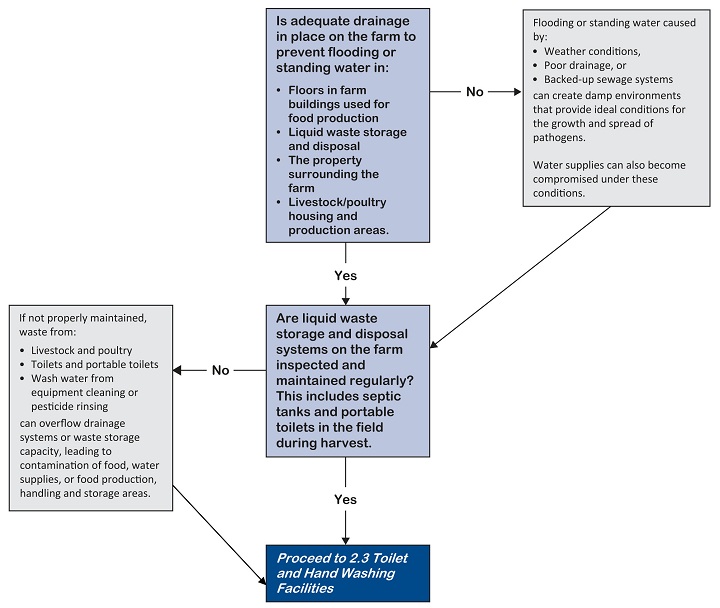Farm buildings and access - 2.2 Drainage and sewage Systems
If inadequate drainage or liquid waste disposal systems are not in place, food, food contact surfaces, inputs, housing areas and the water supply can be contaminated.

This good agricultural practice applies to all farms.
What needs to be done
Make sure facilities and yards have drainage and liquid waste disposal systems designed and maintained to prevent any risk of contamination.
How to do it:
- Use safeguards (for example, dikes, drains, ditches and berms) to protect outdoor facilities and yards from flooding
- Design facilities to promote drainage (for example, floor surfaces sloped to drains)
Take the following into account when designing and constructing septic, liquid waste disposal, and drainage systems:
- Site of drainage system (for example, distance from water supplies)
- Protection of pipes from freezing temperatures in winter
- Volume/capacity of waste liquid generated from production systems
- Install backflow prevention devices to prevent drainage backups
- Maintain liquid waste disposal and drainage systems (for example, empty septic tanks at recommended intervals to ensure sludge buildup does not affect operation)
In general
- Consider what to do in the event of unexpected circumstances, such as flooding or extensive freezing, that creates a food safety hazard
- In the event of a spill, contact your local municipality or your local public health inspector or the Provincial Emergency Program for guidance on how to handle the clean-up
If you need an audit
Be prepared for the auditor to:
- Review documentation and the permit-to-operate for any on-site sewage system
- Review documentation on septic tank pump-outs
- Visually observe for any unusual standing water and accompanying odours
Laws and regulations
There are few laws that directly impact on food safety directly regulating internal drainage and sewage systems in agricultural production. Generally, these requirements are laid out in laws regarding the processing of meat, fish and other food products, which are outside the scope of this document.
- Septic systems are subject to the Sewerage System Regulation, Reg. 326/04, under the Public Health Act
- Note that laws specify that contaminants may not enter water, such as through a drain or due to a spill. The Environmental Management Act, S.B.C. 2003, c. 53, s. 6 (1)-(4) prohibits the discharge of any contaminants into the natural environment
- The Milk Industry Standards Regulation, Reg. 464/81, s. 17, s. 22 under the Milk Industry Act, provides that the floors of dairy barns, milking parlours and milking rooms shall have a sufficient gradient to allow for complete and rapid drainage. Milk houses (s. 25) must have drains that are located in the floor of the milk house at least 60 centimetres. from the outlet of each farm holding tank, have a diameter of at least 10 centimetres, have drain covers that are at least 30 centimetres in diameter, and be fitted with traps
